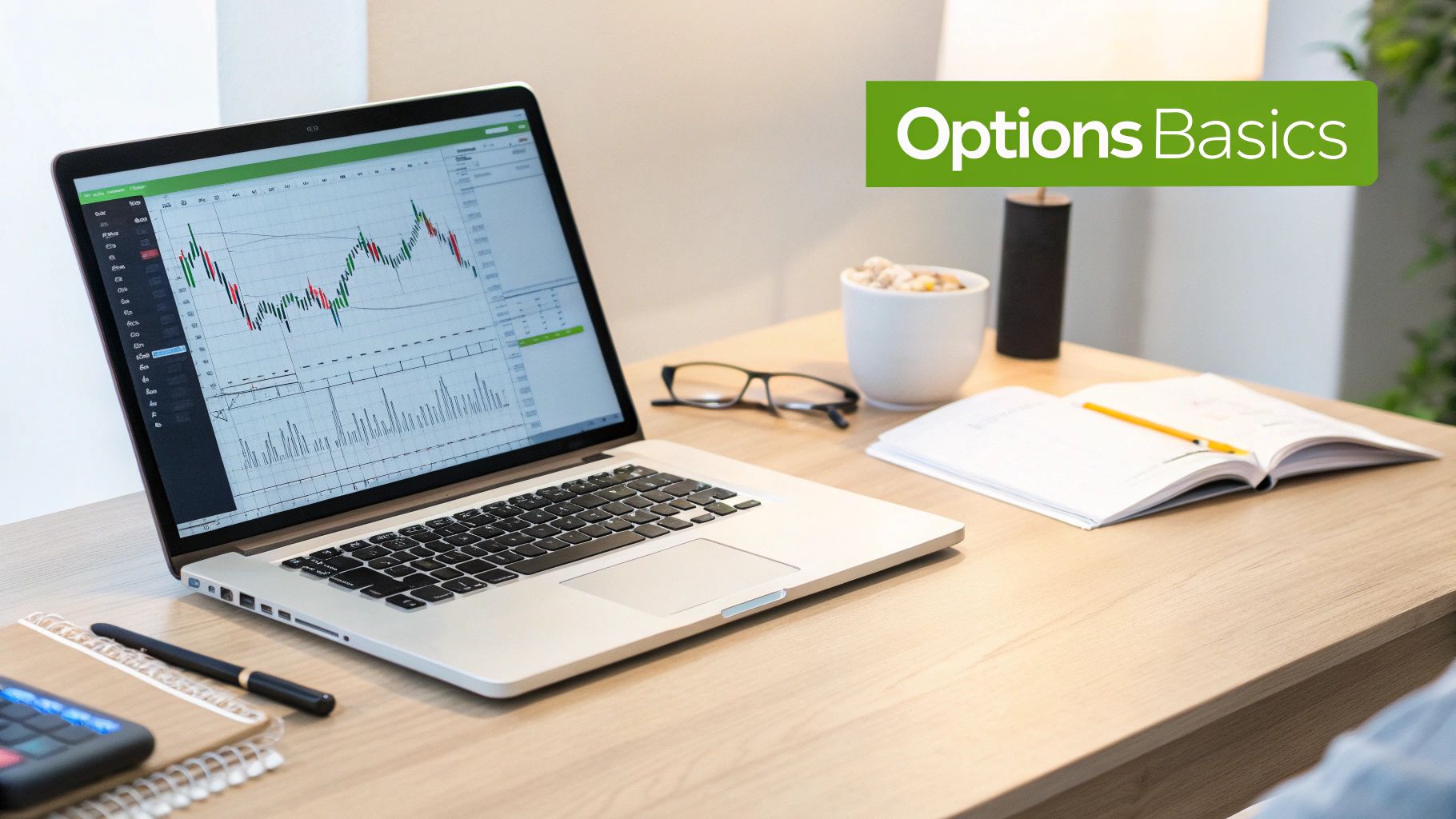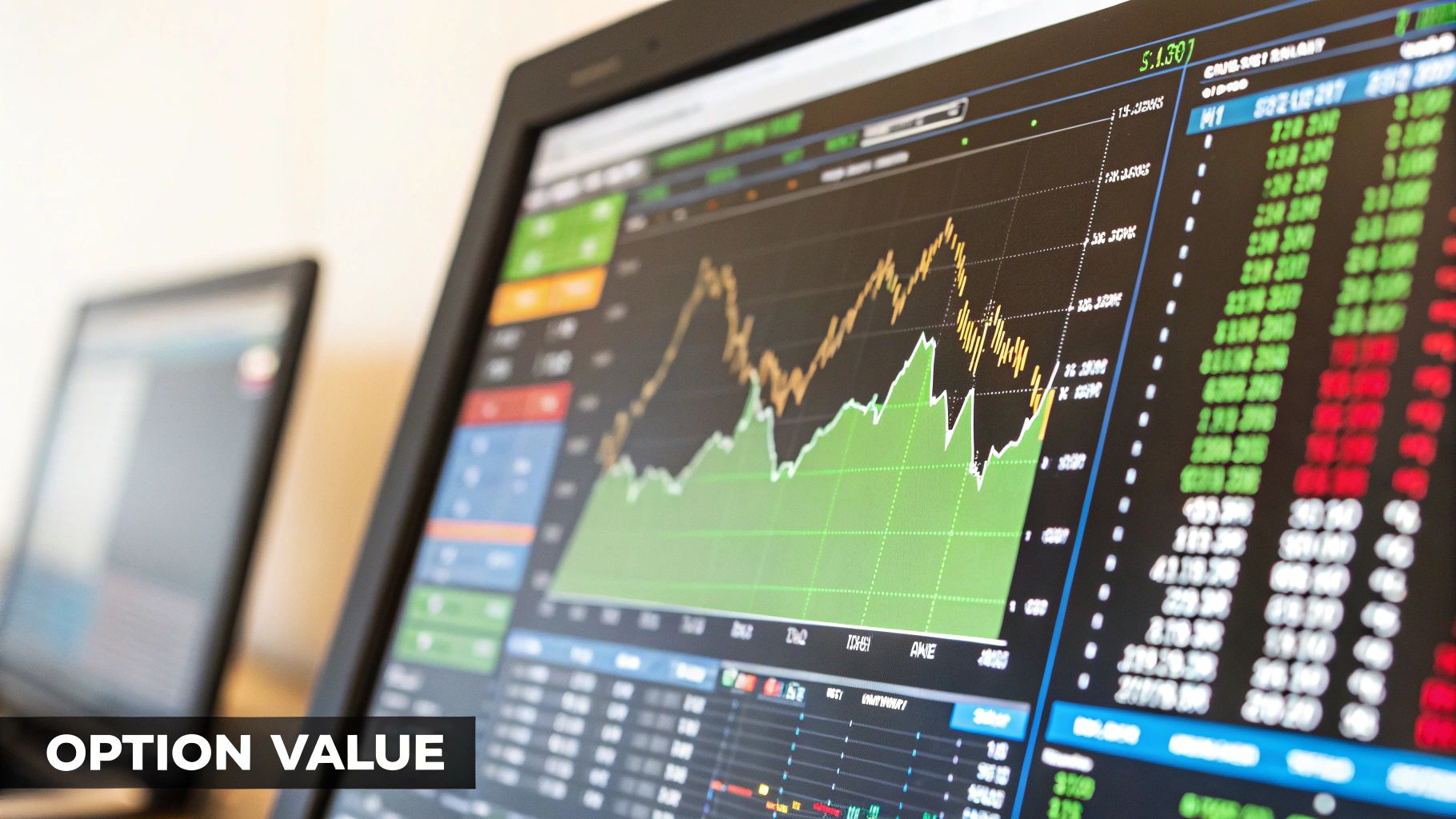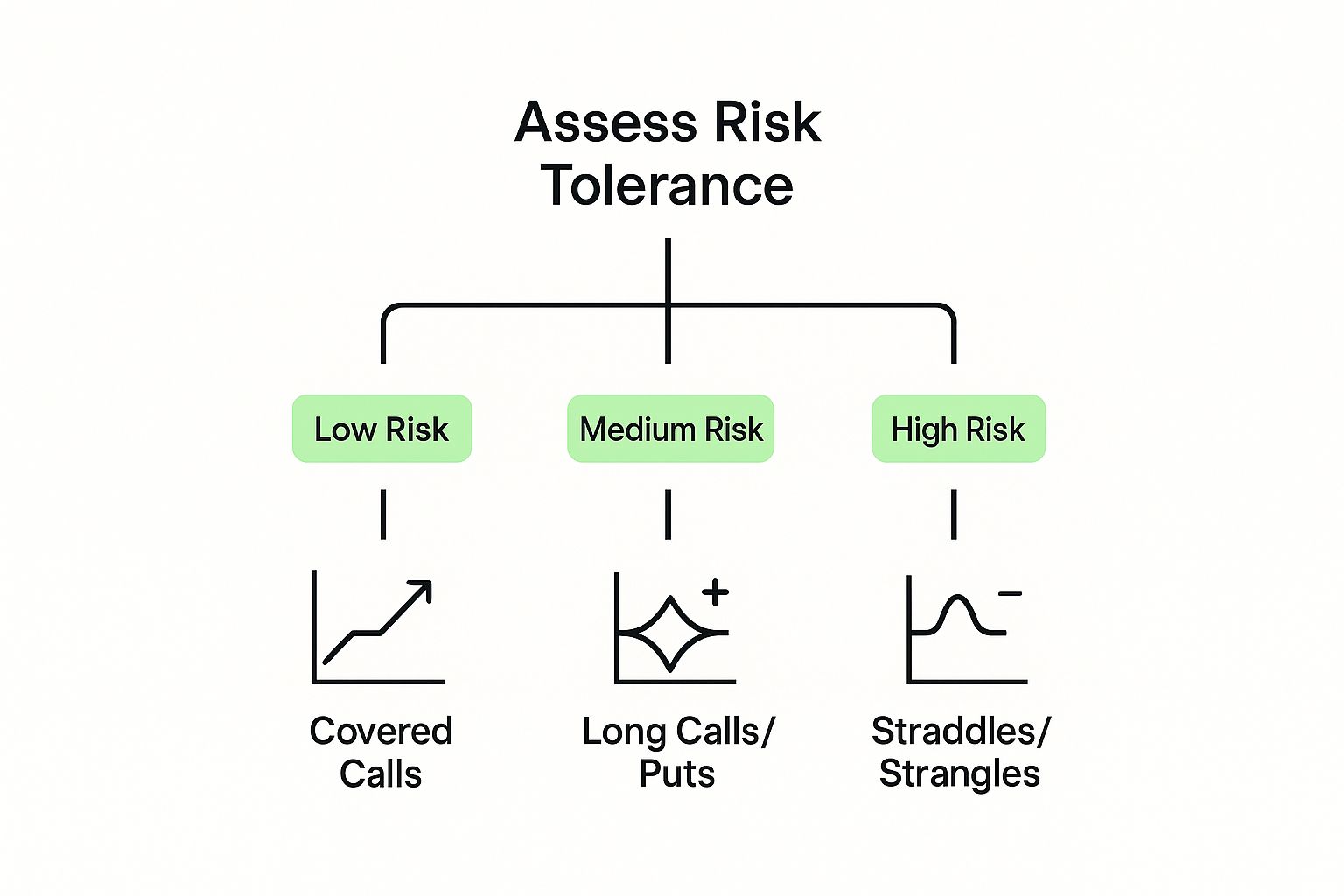How Options Trading Works A Simple Explainer
If a stock moves past your strike, the option can be assigned — meaning you'll have to sell (in a call) or buy (in a put). Knowing the assignment probability ahead of time is key to managing risk.
Posted by
Related reading
Mastering Option Extrinsic Value
Unlock the core of options trading by mastering option extrinsic value. Learn how time, volatility, and strategy impact your profits with this guide.
A Trader's Guide to Short Put Options
Discover how to use short put options to generate consistent income or buy stocks at a lower price. This guide covers key strategies and risk management.
8 Best Stocks for Put Selling in 2025
Discover the best stocks for put selling to generate consistent income. Our guide breaks down top picks, key metrics, and actionable strategies for success.
So, how does options trading actually work? At its core, it gives you the right, but not the obligation, to buy or sell a stock at a set price by a certain date.
Think of it like putting a deposit down on a house. You pay a small fee to lock in today's price, which gives you the choice to buy it later. You're not forced to go through with the purchase, but the option is yours. This simple idea is what allows for some incredibly strategic moves with clearly defined risk.
What Is an Options Contract, Really?

At its heart, an options contract is a financial agreement that gets its value from an underlying asset, like a stock. Instead of buying the stock itself, you're buying the choice to do something with that stock in the future. This is a massive distinction that separates options from just buying and selling shares.
These agreements are a huge part of the global financial system. The US options market is the largest in the world, with exchange-traded options going all the way back to 1973. On any given day, it's not unusual to see the average daily volume for equity and index options soar past 30 million contracts.
The Two Flavors of Options
Every single options contract boils down to one of two fundamental types. The one you choose depends entirely on which direction you think the market is headed. Getting this difference straight is the first real step to understanding how options work.
Call Options: You buy a call when you're bullish—you think a stock's price is going to rise. A call gives you the right to buy that stock at a locked-in price, letting you profit if the market price climbs above your target.
Put Options: You buy a put when you're bearish—you believe the stock's price is headed down. This gives you the right to sell the stock at a locked-in price, which can protect you from a drop or even let you profit from it.
In short, a call is a bet on the price going up, and a put is a bet on the price going down. The price you pay for this right is called the "premium." For an options buyer, the premium is the absolute most you can lose on the trade.
Now, for a quick side-by-side comparison, here’s how the two types stack up.
Call Options vs Put Options At a Glance
| Feature | Call Option | Put Option |
|---|---|---|
| Your Goal | To profit from a price increase. | To profit from a price decrease. |
| Your Right | The right to BUY the underlying asset. | The right to SELL the underlying asset. |
| Best Scenario | The stock price soars far above your strike price. | The stock price plummets far below your strike price. |
| Common Use | Speculating on upward moves or growth. | Hedging against losses or speculating on a downturn. |
This table gives you a simple way to remember the core purpose of each contract type. It all comes back to your prediction: Are you betting on the stock going up or down?
The premium you pay for an option isn't just a random number; it's made up of different components that determine its value. To really dig into why some options cost more than others, it helps to understand intrinsic vs. extrinsic option value and how factors like time and stock price play a huge role.
Learning the Language of the Options Market
To get anywhere in options trading, you first have to speak the language. The jargon might seem a bit much at first, but each term is just a label for a simple, practical concept that defines every single options contract.
Once you get a handle on these core components, you'll be able to look at an options chain and see a clear story of risk and opportunity.
Let's break down the essential vocabulary with a real-world example. Imagine you're interested in a call option for a big tech company, let's call it "Innovate Corp," which is currently trading at $150 per share.
The Four Pillars of an Options Contract
Every options contract is built on four key elements. These pieces of information tell you exactly what right you’re buying or selling.
Strike Price: This is the locked-in price where you get the right to buy (for a call) or sell (for a put) the stock. In our Innovate Corp example, you might choose a call option with a $155 strike price, betting the stock will climb past that level.
Expiration Date: Options don't last forever. The expiration date is the final day you can exercise your right. This could be weeks, months, or even years down the road.
Premium: This is simply the cost of the options contract, paid by the buyer to the seller. Think of it as the fee you pay to secure the choice to buy or sell the stock later. It’s quoted on a per-share basis, but since one contract controls 100 shares, you multiply the premium by 100 for the total cost.
Underlying Asset: This is the stock, ETF, or other security that the options contract is based on. In our case, the underlying asset is 100 shares of Innovate Corp.
A common mistake is confusing the premium with the stock price. The premium is the fee for the contract. It gives you control over 100 shares without needing the cash to buy them all outright. As a buyer, your risk is limited to this premium.
Volatility: The Wild Card in Pricing
Beyond those four pillars, one more concept has a massive influence on an option's premium: volatility. This measures how much a stock's price is expected to swing. The higher the volatility, the greater the chance of big price moves, making the option more valuable—and therefore, more expensive.
This is where implied volatility comes in. It’s a key metric that tells you the market’s expectation of future volatility. The VIX, often called the market's "fear gauge," is a perfect example; it's calculated from S&P 500 index options to show what traders expect for broader market swings. You can dig deeper into how historical data informs volatility on ivolatility.com.
These price movements are measured by what are known as "the Greeks." While that sounds intimidating, they're just risk metrics that help you understand how an option's price is likely to change. Getting a grasp on what the option Greeks are will give you a much deeper feel for how an option will behave as the market shifts. Understanding these terms is the real key to decoding how options trading works.
The Two Sides of Every Options Trade

Every single options trade is a transaction between two people: a buyer and a seller. Think of them as standing on opposite sides of a bet, each with completely different goals, risk levels, and ideas about where the stock is headed.
If you don't understand what motivates both sides of the deal, you're only seeing half the picture. Getting a handle on both perspectives is the key to understanding how options actually work in the real world.
The options buyer, sometimes called the holder, is the one paying money (the premium) for the right to do something later. They’re often chasing a big potential payoff while keeping their risk in check. For instance, a buyer might grab a call option because they believe the stock is about to take off, hoping it soars past the strike price before the contract expires.
On the flip side, the options seller, also known as the writer, is the one collecting that premium. In exchange for that cash, they take on an obligation. They’re now on the hook to make good on the contract if the buyer decides to use their right. For sellers, the name of the game is usually income.
The Buyer’s Game: Capped Risk, Big Potential
When you buy an option—it doesn’t matter if it’s a call or a put—your risk is locked in from day one. The absolute most you can possibly lose is the premium you paid for the contract. That’s it. This built-in safety net is a huge reason why people are drawn to buying options.
Your potential reward, though? That’s a different story. If the stock makes a big move in the direction you predicted, the value of your option can skyrocket, delivering massive returns on what was a relatively small initial investment.
Key Takeaway for Buyers: You're paying for a chance at a big win with limited downside. Your risk is strictly the premium you paid, but your profit potential can be enormous if you get the stock's direction and timing right.
The Seller’s Game: All About Generating Income
So, if the buyer has all that upside, why would anyone take the other side of that trade? Because the seller is playing a totally different game. They aren't looking for a home run. In fact, most of the time, they’re betting that the home run never happens.
A seller’s maximum profit is always capped at the premium they collect right at the start when they sell (or "write") the contract. Their goal is simple: for the option to expire worthless. If it does, they pocket the entire premium, no strings attached. It's a popular way to create a steady stream of cash flow from a stock portfolio you already own.
One of the most common seller strategies is the covered call. This is when an investor who already owns at least 100 shares of a stock sells a call option against those very shares. They immediately collect a premium, which is like earning a little extra dividend on their stock. They accept the "risk" that they might have to sell their shares at the strike price, but they get paid upfront for taking on that obligation.
Placing Your First Options Trade Step-by-Step
Theory is one thing, but the real learning starts when you put your money where your mouth is. Let's walk through the process of placing a simple options trade, from forming an opinion on a stock to clicking the final button. Getting this sequence down is a huge part of understanding how options actually work.
Let's start with a basic market opinion. Say you've been following "Global Retail Inc.," a familiar company currently trading at $50 per share. After a strong earnings report, you’re feeling optimistic and think the stock is poised to climb over the next month.
With a bullish outlook like that, buying a call option makes sense.
Navigating the Options Chain
Your brokerage platform's "options chain" is your menu. It’s where you'll find every available call and put for a stock, all neatly organized by expiration date and strike price. Your job is to pick the right combo that fits your prediction and your comfort level with risk.
Select an Expiration Date: You think the stock will rise within a month, so you look at options expiring in about 45 days. This gives your prediction a little extra runway to come true and helps cushion against the relentless tick-tock of time decay.
Choose a Strike Price: The stock is trading at $50. You could go for a $50 strike (at the money), a $48 strike (in the money), or maybe a $52 strike (out of the money). Each choice comes with its own risk-reward profile.
Making an informed decision is all about matching the strategy to your own risk tolerance. This decision tree helps visualize how different risk levels connect to common options strategies.

As the infographic shows, simply buying calls or puts is generally considered a medium-risk approach, which is why it’s a great starting point for new traders.
Making a Strategic Choice
For this trade, let's say you decide to buy an out-of-the-money call option with a $52 strike price. Why? It's cheaper than an in-the-money option, which keeps your initial cost down. The trade-off, of course, is that the stock has to move up past $52 just to get you to the starting line.
Let's assume the premium for this $52 call expiring in 45 days is $1.50.
Since one options contract controls 100 shares, the total cost for this contract is $1.50 x 100 = $150, plus any small commission your broker charges. That $150 is it. It's the absolute most you can lose on this trade.
Your goal is simple: for Global Retail Inc.'s stock to rise well above $52 before the 45 days are up. Your break-even point is the strike price plus the premium you paid ($52 + $1.50 = $53.50). If the stock hits $55, your option will be worth more, and you can sell it for a profit.
Choosing Your First Option: A Decision Framework
Deciding on the specifics of your first trade can feel overwhelming. This simple framework is designed to connect your market view to the concrete choices you need to make. Think of it as a cheat sheet for translating your opinion into an actionable trade.
| Decision Point | Bullish Outlook (Stock will go up) | Bearish Outlook (Stock will go down) |
|---|---|---|
| Option Type | Buy a Call option. | Buy a Put option. |
| Strike Price | A strike above the current price (OTM) is cheaper but needs a bigger move to profit. A strike at the current price (ATM) costs more but is closer to being profitable. | A strike below the current price (OTM) is cheaper but needs a bigger drop to profit. A strike at the current price (ATM) costs more but is closer to being profitable. |
| Expiration Date | Choose a date far enough out to give your prediction time to happen (e.g., 30-60 days). More time costs more but reduces pressure. | Choose a date that aligns with your timeline for the stock to fall. More time costs more but gives the trade room to work. |
| Your Goal | Sell the call option for a higher premium than you paid as the stock price rises. | Sell the put option for a higher premium than you paid as the stock price falls. |
This table isn't about giving you the "right" answer, but rather guiding your thinking. Your first few trades are about learning the mechanics and seeing how these variables work together in the real world.
Executing the Trade
Once you've zeroed in on the exact contract, placing the order is surprisingly easy. You’ll just need to specify how many contracts you want to buy and the price you're willing to pay. Most trading platforms let you set a "limit order," which is a good practice to ensure you don’t pay more than your target premium.
Here’s a quick mental checklist to run through before you hit the "confirm" button:
- Underlying Stock: Is it the right company? (Global Retail Inc.)
- Option Type: Are you buying a Call or a Put? (Call)
- Expiration Date: Does it give your trade enough time? (45 days)
- Strike Price: Does it match your plan and risk profile? ($52)
- Number of Contracts: How many are you buying? (1)
- Total Cost: Is the total premium an amount you're okay with losing? ($150)
After you’ve double-checked everything, you execute the trade. And just like that, you own a call option on Global Retail Inc., giving you the right—but not the obligation—to buy 100 shares at $52 anytime in the next 45 days.
Congratulations, you've officially placed your first options trade.
Exploring Foundational Trading Strategies

Once you’ve got the core mechanics down, you can start to see how options become these incredibly flexible tools for playing out a specific view on the market. Instead of just betting "up" or "down," traders use strategies to carefully shape their risk and potential reward.
Two of the most fundamental strategies are the building blocks for almost everything else in the options world. They’re the first real, practical answer to the question of how options trading works. Think of them as the essential starting point for acting on your market predictions with a clearly defined risk.
The Bullish Bet: Buying a Call Option
Buying a call option is the classic bullish play. It’s what you do when you’ve got a strong conviction that a stock’s price is heading higher and you want to capture that upside without tying up a ton of capital. The best part? Your risk is strictly limited to the premium you pay for the contract.
Let's walk through an example. Say "Tech Giant Co." (TGC) is trading at $200 a share, and you think it has room to run. You decide to buy one call option.
- Strike Price: $210
- Expiration: 60 days from now
- Premium: $5.00 per share
Your total cost for this one contract is $5.00 x 100 shares = $500. That $500 is the absolute most you can lose on this trade. No surprises.
Now, let's see how it can play out:
- Maximum Loss: Your risk is capped right at the premium you paid, which is $500.
- Break-Even Point: For the trade to turn a profit, TGC needs to climb past your strike price plus the premium. That means $210 + $5 = $215.
- Maximum Profit: This is where it gets exciting—your potential profit is theoretically unlimited. If TGC stock absolutely soars to $250, your option gives you the right to buy shares at $210, locking in a $40 per-share value.
This strategy is all about leveraged gains. You essentially controlled 100 shares of a $200 stock (a $20,000 position) for just $500. If the stock moves your way, the percentage return on your initial investment can be massive.
The Bearish Play: Buying a Put Option
But what if you think a stock is overvalued and due for a fall? That’s where buying a put option comes in. It’s a direct bet that a stock’s price is going down. Traders also use this strategy as a form of insurance to protect their existing stock holdings from a potential market downturn.
Imagine "Pharma Innovators" (PHI) is trading at $80, but you're worried about an upcoming report and expect the price to drop. You decide to buy one put option.
- Strike Price: $75
- Expiration: 45 days from now
- Premium: $3.00 per share
Your total cost—and your maximum risk—for this trade is $3.00 x 100 shares = $300.
Here’s the breakdown of this bearish trade:
- Maximum Loss: Just like with buying a call, your risk is limited to the premium you paid: $300.
- Break-Even Point: You start making money once the stock price drops below your strike price minus the premium. So, $75 - $3 = $72.
- Maximum Profit: Your profit potential here is substantial, and it grows as the stock price falls. Your theoretical maximum profit happens if the stock goes all the way to $0.
Of course, these are just two basic approaches. To see how these building blocks can be combined, check out our guide on other foundational options trading strategies for beginners that can help you match a plan to your market outlook.
Common Questions About Options Trading
As you start wrapping your head around options, a few key questions always pop up. These are the practical, "what-if" scenarios that bridge the gap between theory and actually putting your money to work. Let’s tackle a few of the big ones to clear up any confusion.
Do I Have to Own 100 Shares to Trade Options?
Nope, not at all. One of the biggest draws of options is the ability to trade contracts without ever touching the underlying stock. This lets you speculate on where a stock might go using way less capital than buying the shares outright.
However, there's a big exception for certain strategies. If you're selling a covered call—a super popular strategy for generating income—you absolutely must own at least 100 shares of the stock to "cover" your position. Think of those shares as your collateral; they're what makes that specific trade a whole lot safer.
What Happens When My Option Expires?
It all comes down to one thing: is your option "in the money" (has value) or "out of the money" (worthless)?
Out of the Money: If your option is worthless when the clock runs out, it just vanishes. Poof. The premium you paid is gone, and the trade is over.
In the Money: If your option has value, your broker will likely exercise it for you automatically. For a call, this means you'll buy 100 shares at the strike price. For a put, you'll sell 100 shares.
But here’s the thing: most traders don't let it get to that point. They usually sell their profitable options for cash before they expire. This locks in the profit without the headache or capital commitment of suddenly owning 100 shares.
Key Insight: Most retail traders treat the option contract itself as the investment. The goal isn't to own the stock; it's to sell the contract for a profit before it expires.
What Are the Main Risks in Options Trading?
While options are incredibly flexible, the risks look very different depending on which side of the trade you're on.
For an options buyer, the risk is simple and capped. The absolute worst that can happen is you lose the premium you paid for the contract. That’s it.
For an options seller (often called a "writer"), the risk can be much, much scarier. Someone selling a "naked" or "uncovered" call theoretically has unlimited risk, because there’s no ceiling on how high a stock's price can climb.
And then there's the one risk everyone faces: time decay, known by its Greek name, Theta. Every single day, your option bleeds a tiny bit of value, even if the stock price doesn't budge. Time is a constant enemy for the buyer and a reliable friend for the seller.
Can I Lose More Money Than I Invest?
This is a critical question, and the answer is a firm "it depends on what you're doing."
If you are only buying calls or puts, you can never lose more than you invested. Your maximum loss is baked in—it's the premium you paid to open the trade. This defined risk is a massive advantage for buyers.
On the flip side, if you are selling (writing) options—especially "naked" ones—your potential losses can absolutely blow past your initial investment. Selling uncovered options is a high-stakes game, and it’s a strategy best left to seasoned traders who fully understand what they're getting into.
Ready to turn guesswork into informed action? Strike Price provides real, data-driven probability metrics that help you sell options with confidence. Our platform offers smart alerts and tailored strategies to help you balance safety and premium yield, making it easier to generate consistent income. Find out how thousands of traders are optimizing their strategies at https://strikeprice.app.